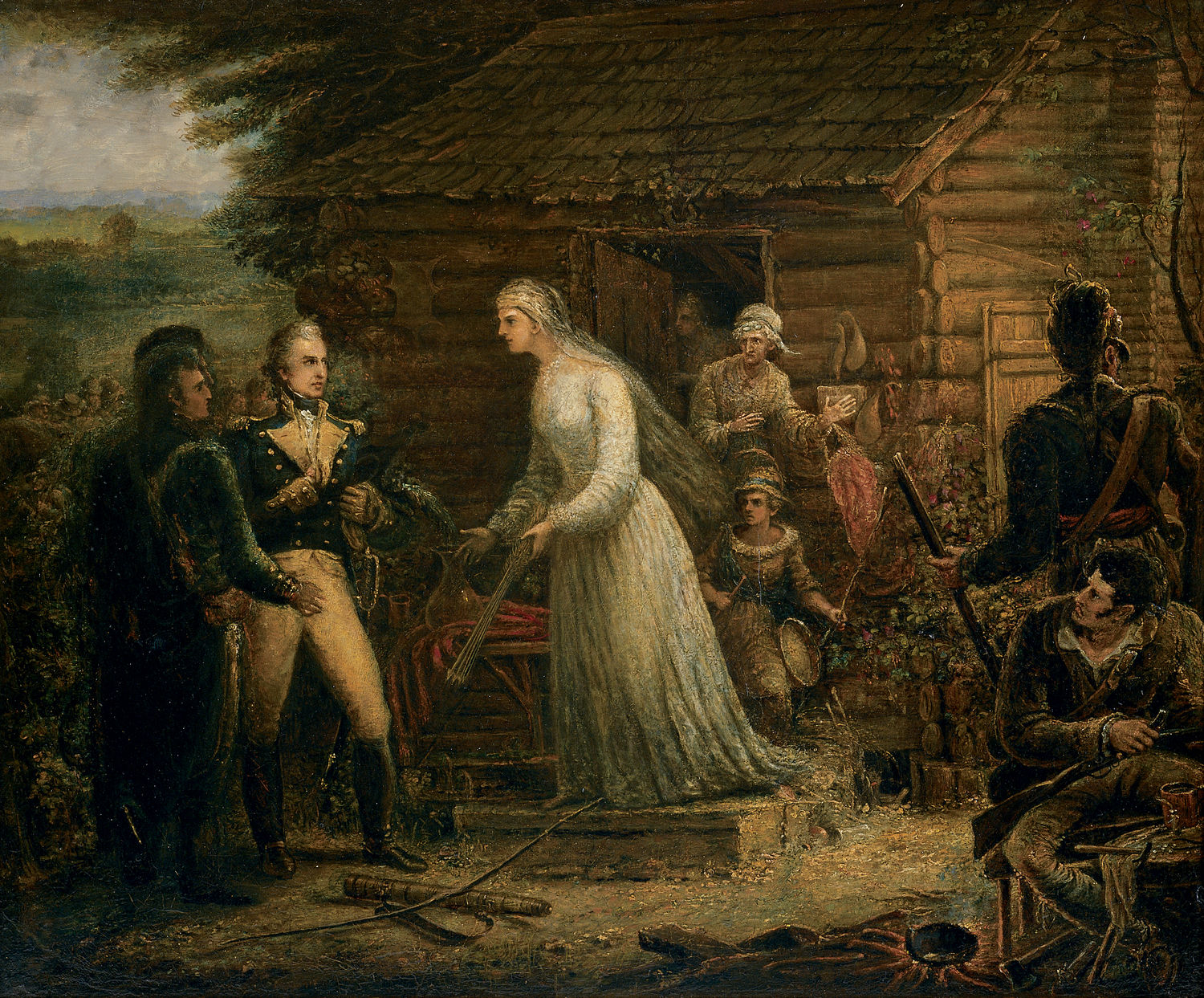
| Title | Mrs. Motte Directing Generals Marion and Lee to Burn Her Mansion to Dislodge the British |
| Artist/Maker | John Blake White ( 1781 - 1859 ) |
| Date | n. d. |
| Medium | Oil on canvas |
| Dimensions | Sight: h. 24.5 x w. 29.625 in. (h. 62.23 x w. 75.2475 cm)
Framed: h. 34.25 x w. 39.25 in. (h. 86.995 x w. 99.695 cm) |
| Credit Line | U.S. Senate Collection |
| Accession Number | 33.00001.000 |
In this painting, Mrs. Motte Directing Generals Marion and Lee to Burn Her Mansion to Dislodge the British, Rebecca Motte, in the center, offers arrows to Marion, Lee, and another soldier between them so they might shoot them at the roof of her house. While three members of her household observe her daring act, two soldiers, at right near the campfire, prepare their weapons for the bombardment.
Historical accounts say, as John Blake White has depicted here, that General Francis Marion and Colonel Henry Lee were present when Rebecca Motte consented to the burning of her home. Both Marion and Lee were well known for their military expertise; Marion earned the nickname the “Swamp Fox” for his elusive tactics that disrupted the British supply lines and hampered enemy communications, and Lee was nicknamed “Light Horse Harry” for his frequent successes as outpost leader.
When the British claimed her house as a military post, Rebecca Motte–-whose husband had died during the early part of the war–-was living there with her three daughters and her niece, Mary John Brewton. Lee described the Motte estate as being “situated on a high and commanding hill . . . surrounded with a deep trench, along the interior margin of which was raised a strong and lofty parapet.” [1] Of the burning of her house, Rebecca Motte is said to have told Lee, “If it were a palace, it should go.” [2] The combustible arrows presented to Lee, which Rebecca carried in the protective case located under a bow at her feet in this painting, had belonged to her brother, Miles Brewton. She is said to have inherited them, along with the house, when Brewton was lost at sea. After the roof of the house was set on fire, the British surrendered immediately. The fire was extinguished, and the building was saved from destruction. Fort Motte remained intact until it was accidentally burned several years after the Revolution. A granite stone now marks the site where the British surrendered on May 12, 1781.
South Carolina artist John Blake White studied under painter Benjamin West in England, acquiring West’s interest in historical events and heroic traditions. White’s portrayal of the burning of Mrs. Motte’s house, thought to have been painted about 30 years after the episode, is based on the historical event as well as the legend surrounding it. The dramatic work is comparable in approach and subject matter to Emanuel Leutze’s 1852 canvas, Mrs. Schuyler Burning Her Wheat Fields on the Approach of the British, now in the collection of the Los Angeles County Museum of Art. Such history paintings highlighted intrepid individuals and valorous acts rather than complex scenes of battle. In this painting, White depicts a scene and heroes important especially to South Carolinians.
The painting was one of three historical scenes presented to the Senate in 1899 by Octavius A. White, the son of the artist. He donated a fourth painting two years later. The four paintings are considered the best-known works of John Blake White. In addition to this one, they are The Battle of Fort Moultrie, Sergeants Jasper and Newton Rescuing American Prisoners from the British, and General Marion Inviting a British Officer to Share His Meal. In a letter to Senator Benjamin R. Tillman of South Carolina, Octavius White stated that he wished to donate the four paintings to the United States Senate in memory of his father.
1. Henry Lee, The Revolutionary War Memoirs of General Henry Lee, originally published as Memoirs of the War in the Southern Department of the United States (1812; reprint, New York: Da Capo, 1998), 345.
2. Robert D. Bass, Swamp Fox: The Life and Campaigns of General Francis Marion (New York: Holt, 1959), 193.
During the Revolutionary War, British troops seized the strategically located mansion of Rebecca Jacob Motte, a wealthy widow. Located midway between Charleston and Columbia, South Carolina, on the Congaree River, the house became a principal supply depot for the British campaign in the South. Garrisoned with about 200 soldiers, the bulwark was known by the British as Fort Motte. American forces sought to destroy their enemy's interior chain of military posts, including Fort Motte, to gain control of everything within 30 miles of the sea. Despite the British occupation, Rebecca Motte and her family remained in her house until the American forces–-under the command of General Francis Marion and Lieutenant Colonel (later General) Henry Lee–-arrived, demanding that the British surrender. The Motte family was asked to retreat to a farmhouse nearby, and on May 8, 1781, Marion and Lee attacked the plantation to reclaim it for the colonial army. Rebecca Motte reportedly encouraged the Americans to set the house afire in order to dislodge the British. She herself is said to have provided the arrows used to ignite the roof. The British soldiers surrendered, fearing they would be blown up if the gunpowder stored in the house were set on fire. Following the successful American siege, Rebecca Motte provided a dinner to the officers of both armies.